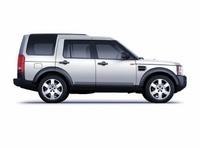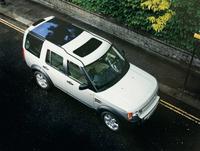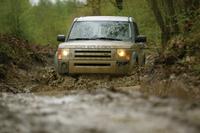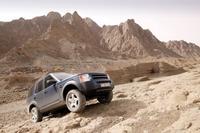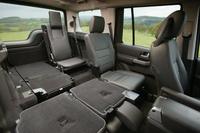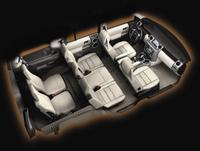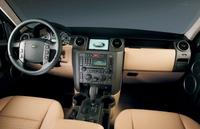New Car Review: 2005 Land Rover LR3
The all new 2005 Land Rover LR3
A quantum leap in the evolution of the SUV
By Manrico Delcore & Mary Beth Debicki
The all new 2005 Land Rover LR3 (or Discovery 3 as it will be known outside North America) is the first Land Rover to be designed since Land Rover and BMW parted ways in mid-2000 and it represents a re-affirmation of Land Rover’s heritage. At a time when SUV manufacturers are quick to trade off road capability for on road, car-like handling, Land Rover has gone the extra mile and crafted a vehicle that is supremely capable off road and a pleasure to drive on-road. A vehicle that is equally at home in the plains of Africa as on the freeways of LA.
The LR3 is a completely new Land Rover and it introduces more new and cutting edge technology than any SUV ever has. Technology that works to enhance both on road performance and off road capability. Take the suspension for example, front and rear fully independent suspension and air springs give the LR3 a smooth, comfortable ride and precise car-like handling. Yet, when the vehicle detects off road conditions, it cross-links the air springs so that “air displaced by the upward movement of an air spring is transferred to the spring on the opposite side, forcing it down, improving composure and wheel contact with the terrain.” Thus, off road the suspension mimics a traditional beam axle for increased ground clearance, wheel articulation and traction. Who said you can’t have your cake and eat it too!
Progressive, hydraulically operated, power-assisted rack-and-pinion steering gives LR3 precise, solid and responsive steering. Together with the front/rear double wishbone suspension, the LR3 handles like a well mannered sedan and not the 6,000 pound vehicle it is. Driving twisting roads no longer feels like an aerobic exercise, the LR3 tracks precisely and predictably throughout the turns, even at speeds.
And speaking of speeds, this Land Rover goes from 0-60 in 8 seconds, thanks to a Jaguar 4.4 Liter V-8 that cranks out 300 bhp and 315 ft-lb of torque. This powerplant is a modified version of Jaguar’s 4.2 Liter V8. The increase in bore wasn’t the only modification the folks at Solihull performed. The engine’s “mapping” was redesigned to increase torque and to deliver maximum torque at a lower rpms, and because Land Rovers are expected to operate in extreme environments, the Jaguar engine received water-, dust- and mud-proofing. Oil capacity was also increased by nearly 2 liters to insure engine proper engine lubrication even at the extreme angles Land Rovers often find themselves in.
As impressive as LR3’s handling and performance on road are, it is off pavement that this vehicle proves without a doubt that it is pure and true Land Rover. With short front and rear overhangs the LR3 has excellent approach and departure angles, and with all “vitals” tucked-up into the “body-frame”, ground clearance is an amazing 9.5 inches. But it is the way that technological advances have been integrated together that makes the LR3 nearly unstoppable.
The keystone of LR3’s off pavement prowess is Land Rover’s “Terrain Response” system. Land Rover engineers analyzed over 50 different off road terrains and determined the individual engine, transmission, suspension, traction and other vehicle system inputs needed to optimize the vehicle’s performance in each terrain. According to Steve Haywood “we concluded that these [system inputs] can be distilled into just a handful of programs – and those are the settings we offer on Terrain Response”. The driver chooses from among 6 terrains, such as sand, mud & ruts, rock crawling, and the terrain response “black box” configures a number of vehicle systems for optimum performance.
Terrain Response adjusts the air suspension for maximum ground clearance, adjusts the automatic gearbox to optimize gear change points, and alters the throttle map and accelerator pedal response. Traction control and brakeforce distribution are all adjusted to the terrain setting. Land Rover’s patented Hill Descent Control is also adjusted and downhill speed rates vary depending on the terrain, even the center and rear locking differentials use different locking rates depending on terrain.
Sitting behind the wheel felt both familiar and new. The inside is all new, yet is very Land Rover. Large instrumentation, a minimum of switches, and strong vertical lines give the LR3’s fascia a simple and efficient look. There are nonetheless plenty of storage compartments and, yes, drink holders. From the driver’s seat, LR3 feels at once roomy, there’s plenty of elbow room, and compact, all the controls are within easy reach.
LR3 preserves Land Rover’s “Command driving position” and thanks to the stepped roof, the 2nd and 3rd row passengers still enjoy “stadium seating”. The interior is roomy with all seats accommodating “95 percentile” of adults. The cabin is one of the brightest and airiest thanks to the full width glass roof. When not needed, the 2 and 3 rows of seats fold flat into the floor crating an amazingly large and useful flat load space. The passenger doors have grown wider making getting in and out of the vehicle much easier than in previous models.
Mike O’Driscoll, president of Aston Martin Jaguar Land Rover North America summed it up best when he said “[LR3] blends innovative technology and refinement with traditional Land Rover strengths to rewrite the definition of a modern, premium SUV”.
TECHNICAL SPECIFICATION
ENGINE
Type Longitudinal No. cylinders / valves V8, 4 valves per cylinder Displacement 4.4 liter (268 cu. in. / 4394 cc) Bore x Stroke 3.465 x 3.555 in. (88 x 90.3 mm) Compression Ratio 10:5:1 Max. horsepower @ rpm 300 hp @ 5500 rpm Max. torque @ rpm 315 lb.-ft. @ 4000 rpm PERFORMANCE Performance, 0-60 mph 8.0 sec. Maximum Speed 121 mph DRIVETRAIN Drive System Permanent four-wheel drive with optional locking center and rear axle differentials Traction Control Four-wheel Electronic Traction Control (4ETC) Transmission ZF HP26 six-speed electronically controlled automatic with Command Shift(tm) manual control. Locking torque converter. Normal, sport and manual shift Gear Ratios (High/Low) First Second Third Fourth Fifth Sixth Reverse 15.558:1 / 45.581:1 8.723:1 / 25.588:1 5.673:1 / 16.636:1 4.263:1 / 12.496:1 3.234:1 / 9.474:1 2.557:1 / 7.535:1 12.693:1 / 37.151:1 Final Drive Ratio (High/Low) 1.00:1 / 2.93:1 Transfer Box Ratio High 1.00:1 Transfer Box Ratio Low 2.93:1 SUSPENSION Front Suspension Independent double wishbone Rear Suspension Independent double wishbone STEERING Type Rack-and-pinion Turns, Lock-to-Lock 3.3 Turning Circle, Curb-to-Curb 37.57 ft. (11.45 m) BRAKES System Power-assisted four-wheel disc Front 13.27 in. (337 mm) ventilated disc Rear 13.78 in. (350 mm) ventilated disc Park 8.27 in. (210 mm) duo servo WHEELS & TIRES SE Model Wheel 18 x 8-inch aluminum alloy wheels SE Model Tire 255/60R18 H & V all-terrain HSE Model Wheel 19 x 8-inch aluminum alloy wheels HSE Model Tire 255/55R19 H & V all-terrain EXTERIOR DIMENSIONS Overall Length 190.3 in. (4835 mm) Overall Width (excluding/including mirrors) 75.4 in. (1915 mm / 2190 mm) Overall Width with mirrors folded 2009 mm Overall Height (glass/fixed roof) 74.1 in. (1882 mm / 1887 mm) Overall Height (with sunroof open) 1920 mm Overall Height with roof side rails 1891 mm Wheelbase 113.6 in. (2885 mm) Drag coefficient 0.41 Cd INTERIOR DIMENSIONS Seating Capacity Five (seven optional) Head Room in row two, fixed roof 1043 mm Head Room in row two, glass roof 1076 mm Shoulder Room, Front/Rear in row two 1503 mm / 1508 mm Leg Room in row two 955 mm Maximum loadspace volume 2558 liters OFF-ROAD CAPABILITIES Ground Clearance - Standard Ride Height 7.3 in. (185 mm) Ground Clearance - Off-Road Height 9.4 in. (240 mm) Suspension articulation front/rear 255 mm / 330 mm Angle of Approach 37.2 degrees Angle of Departure 29.6 degrees Ramp Breakover Angle 27.9 degrees Wading Depth 700 mm WEIGHTS & TOWING CAPACITY Curb Weight 5,426 lb. (2461 kg) Gross Vehicle Weight Rating 7121 lb. (3230 kg) Trailer Without Brakes 1654 lb. (750 kg) Trailers With Brakes 7716 lb. (3500 kg) Front Axle Load 3197 lb. (1450 kg) Rear Axle Load 4134 lb. (1875 kg) FUEL Fuel Tank Capacity 22.8 U.S. gallons (86.3 liters)



